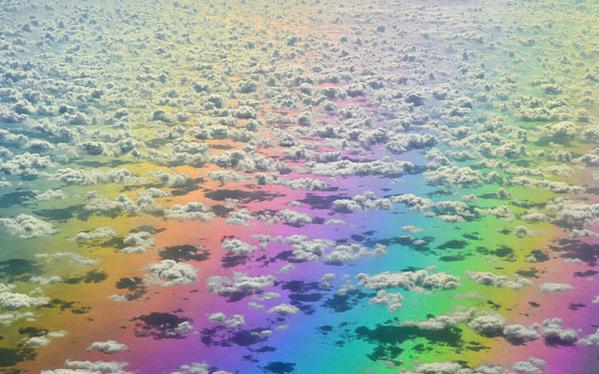
No, you can’t fly over a rainbow
- that would break the laws of physics
Reports that a passenger photographed a rainbow from her plane are mistaken.
The colours are caused by polarisation
The colours are caused by polarisation

This cannot be photographed from above.
Photograph: Fabrice Coffrini/AFP/Getty Images
Scientists can rest easy. Colourful “rainbow” pictures do not break
the laws of physics.
The airline passenger Melissa Rensen, from London, Canada,
took the photographs out of an aircraft window as she flew over
the Caribbean Sea. Only later did she realise that the shots made it
look like the plane was flying over a rainbow.
took the photographs out of an aircraft window as she flew over
the Caribbean Sea. Only later did she realise that the shots made it
look like the plane was flying over a rainbow.

The pictures sparked a flurry of news stories about her literally flying over a rainbow.
But according to physics, this is impossible.
Rainbows are formed when sunlight hits water droplets in the atmosphere.
The water splits the sunlight into its constituent colours and reflects them
at an angle of about 42 degrees, causing the rainbow to appear in the sky.
The rainbow is an optical illusion that depends upon the angle between the sun,
the droplet and the observer remaining constant at 42 degrees.
So it is impossible to see a rainbow in front of you and then be able to fly over
it because as the angles change, the rainbow phenomenon will disappear or
reappear in a different place.
There could be situations when a rainbow appears briefly to one side
or below a plane if the angles all add up right but that is not the case here.
So what caused the colours in Rensen’s photographs?
It all comes down to a property of the aircraft’s window known as birefringence.
Plastic in an aircraft’s window displays the property of birefringence.
This splits light entering it into two distinct rays.
The two rays have their colours dispersed differently as well.
As the light emerges from the window, the two rays of light interfere with each
other creating the coloured bands.
The effect is most obvious when a polarising filter is used on the camera
taking the picture.
The ocean surface also acts like a polarising filter.
When sunlight reflects from the water, it becomes polarised.
This means that the rays of light are made to oscillate in a predominant direction.
Daylight is also polarised because it has been scattered by the molecules of
the Earth’s atmosphere. Blue light is scattered more effectively than red light,
which is why the sky is blue.
All of these factors conspired to produce the coloured bands seen in the photographs.
Not a rainbow.
https://www.theguardian.com/scien
The water splits the sunlight into its constituent colours and reflects them
at an angle of about 42 degrees, causing the rainbow to appear in the sky.
The rainbow is an optical illusion that depends upon the angle between the sun,
the droplet and the observer remaining constant at 42 degrees.
So it is impossible to see a rainbow in front of you and then be able to fly over
it because as the angles change, the rainbow phenomenon will disappear or
reappear in a different place.
There could be situations when a rainbow appears briefly to one side
or below a plane if the angles all add up right but that is not the case here.
So what caused the colours in Rensen’s photographs?
It all comes down to a property of the aircraft’s window known as birefringence.
Plastic in an aircraft’s window displays the property of birefringence.
This splits light entering it into two distinct rays.
The two rays have their colours dispersed differently as well.
As the light emerges from the window, the two rays of light interfere with each
other creating the coloured bands.
The effect is most obvious when a polarising filter is used on the camera
taking the picture.
The ocean surface also acts like a polarising filter.
When sunlight reflects from the water, it becomes polarised.
This means that the rays of light are made to oscillate in a predominant direction.
Daylight is also polarised because it has been scattered by the molecules of
the Earth’s atmosphere. Blue light is scattered more effectively than red light,
which is why the sky is blue.
All of these factors conspired to produce the coloured bands seen in the photographs.
Not a rainbow.
https://www.theguardian.com/scien


Δεν υπάρχουν σχόλια:
Δημοσίευση σχολίου